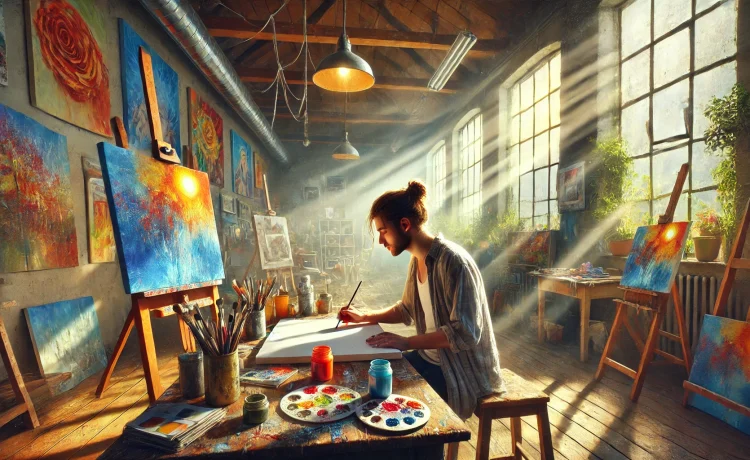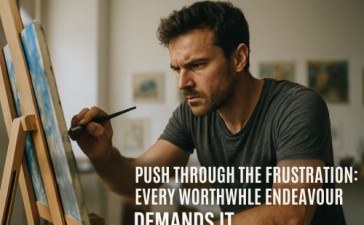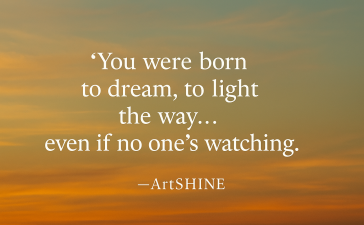Young Harrison Lamoureux in this Studio in Vietnam, 2009
The saying “Do what you love, and you’ll never work a day in your life” is everywhere, touted as the ultimate career goal. But for artists, surface designers, and creatives trying to build a lasting, income-generating career, this statement oversimplifies the reality of making a living in a competitive, demanding industry. If you’re an artist, you know that pursuing what you love still involves a lot of actual work—and sometimes that work can be tedious, stressful, and even discouraging. Yet, with patience, resilience, and a solid support system, it’s possible to grow into a successful, fulfilling career.
The Reality Behind “Doing What You Love”
In the world of art licensing and surface design, doing what you love often means spending significant time and energy on tasks that don’t look or feel like the romanticized idea of “following your passion.” Here’s a look at the real work involved:
- Sending Dozens of Pitches That May Go UnansweredReaching out to potential clients, art directors, and licensing partners is crucial for exposure, but it’s also labor-intensive and often discouraging. For every acceptance, you might face dozens of rejections or, even more frustratingly, complete silence. Yet, consistent pitching is essential to keep your art in front of people who might one day say “yes.” Artists who make it understand that pitching is part of the journey and view each rejection as a stepping stone rather than a dead end.
- Creating Hundreds of Designs, Not All of Which Will SellDeveloping a portfolio means producing work regularly, even if not every design makes it to a sale. This is especially true for surface designers, who need to stay relevant and produce designs that resonate with current trends. For instance, a pattern you designed last year may not find a buyer until months later, if at all. Artists in this space often compare it to a marathon rather than a sprint—it’s about building a body of work that gradually finds its audience.
- Staying Relevant Through Constant Learning and ExperimentationTo maintain a competitive edge, artists have to evolve continuously, experimenting with new styles, techniques, and trends. This isn’t just about artistic growth; it’s a necessity for staying marketable. Whether it’s mastering a new software tool, exploring new mediums, or adapting to digital trends, successful artists know they can’t afford to become stagnant. For example, some artists might start with watercolors and then explore digital pattern-making or 3D art, expanding their skill set to align with what the market demands.
- Researching Trends to Stay AheadTrend research is an essential part of the business, especially for surface designers whose work is often used in fashion, home décor, and stationery. This means keeping an eye on color forecasts, studying what’s popular, and anticipating shifts in demand. It’s a challenging balance: you want to create work that feels authentic, yet aligns with current trends. Smart designers learn to infuse trends into their unique style rather than following them blindly, ensuring their work remains fresh yet personal.
- Competing Against AI Art and Art TheftWith the rise of AI-generated art and increased accessibility to design tools, competition has never been fiercer. Additionally, art theft has become a growing issue, with artists finding their work reposted or copied without permission. This environment can feel discouraging, but it’s also why developing a unique, identifiable style is essential. Artists who succeed in this climate often have a distinct voice that can’t be easily replicated by AI or imitated by others.
- Juggling Business Tasks Alongside CreativityArtists don’t just create; they manage businesses, handling everything from marketing and client negotiations to bookkeeping. For many creatives, managing social media, invoicing, and negotiating contracts is not the “fun” part of the job, yet it’s just as necessary. In a typical week, an artist might switch from designing new pieces to scheduling posts on social media, updating their online portfolio, managing client inquiries, and more.
Embracing the Journey: Patience, Resilience, and the Power of Support
Building a career in art takes time, and it’s rare to achieve financial stability overnight. Here’s what can help make the journey more sustainable and rewarding:
- Having a Team of Helpers
Smart creatives recognize that they don’t have to do everything themselves. Working with a coach, licensing manager, or agent can make a world of difference, allowing artists to focus more on their work while leaving outreach and client negotiations to experts. For instance, a licensingmanager can help artists submit their designs to the right markets, leveraging their network to open doors and get more visibility.
- Remembering That Every Artist’s Journey Is DifferentComparison is often a source of stress and can kill creativity. Every artist’s journey is unique, and progress is rarely linear. Some artists may break into the industry quickly, while others build slowly. Staying focused on your personal goals and growth, rather than comparing yourself to others, can help keep you motivated and grounded.
- Continuing to Learn and GrowSuccessful artists are lifelong learners who continually expand their skills. Whether it’s improving technical proficiency or understanding new trends, growth is key to longevity in the art world. Artists who commit to regular learning and self-improvement often find that this dedication attracts more clients and opportunities over time.
- Building Consistency and AuthenticityYour audience, and ultimately, your clients, are drawn to authenticity. Artists who stay true to their voice and values often find a loyal following, even if it takes time. Consistency in creating and putting yourself out there—through portfolio updates, regular social media engagement, and new designs—helps your work become recognized and appreciated over time.
Final Thoughts: The Reward Is in the Journey
The path to a sustainable art career isn’t easy. It’s filled with challenges, slow progress, and countless behind-the-scenes tasks that might make it feel like “work.” But as you gain momentum, build resilience, and grow through every rejection and success, the journey itself becomes rewarding.
So, instead of focusing solely on “doing what you love,” consider shifting to “doing the work that makes what you love possible.” The key to a fulfilling creative career is understanding that the work itself, the learning, the growth, and the dedication are what make the journey worthwhile. Keep creating, stay consistent, and remember that every step, every piece of work, and every lesson is bringing you closer to your purpose. Your audience is out there; you just have to keep going until they find you.
By redefining what it means to “do what you love,” you can create a fulfilling career that feels authentic and true, embracing the highs, lows, and everything in between.
Want to learn more?
- Find out more
- Launch Pad + Accelerator Expressions of Interest
- Selling and Licensing Your Art & Designs Around the World with ArtSHINE.
We’re here to help you to take action, just like we’ve helped thousands of other entrepreneurs, business owners, and creative professionals all around the globe.
Now is the time to let your passion SHINE.
Now is the time to Make Tomorrow Today!
To your success, Vinh Van Lam and Stuart Horrex Cofounders
ArtSHINE.com





